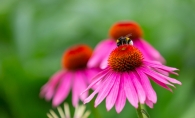
What would it be like to move into a home on the Anoka sand plain where potatoes were once farmed and the sun bakes the grass and everything else? Julie Dahl and her husband, Arthur Dickson, took the challenge 25 years ago and have since created what Dahl calls, “a free-spirited, sunny garden with a large number of native plants.”
The first summer they made raised vegetable beds, spread woodchips along the back of the house where the sod had died and planted trees, adding flowers and other plants around each tree. As the gardens around the trees expanded, they eventually merged with one another.
Eleven years ago, the tree in the front yard fell during a tornado. This created a sunny front yard again. In its place, the couple planted four trees close together: maple, crabapple, tamarack and later, cherry. This provided shade quickly. Today, the garden around the trees includes little bluestem grass—a native with dark red tips on the leaves—butterfly weed and spotted Joe pye weed, both native hosts to monarch butterflies.
Dahl grew up in Duluth. One day while she and her late mother were shopping at a garden store, they discovered something perfect for the front yard garden area: a bench, weighing more than 200 pounds and made of taconite—a reminder of the North Shore.
Dahl, a master gardener, plants as many natives as she can. She says, “If the plant doesn’t survive, it doesn’t. I plant something else. If it thrives, I plant more.” She does all the planting herself, while her husband’s contributions include building fences as needed, around the vegetable gardens; mowing the lawn and cutting down dead branches.
When weeds began to take over near the front curb, Dahl planted flowers there. These include meadow sage, excellent for dry, hot places; blazing star with purple spikes, a native that tolerates drought; and golden lemon thyme, an edible, bright chartreuse groundcover.
Behind the Fence
In the backyard, near the house and deck, bee balm attracts bees and butterflies. Orange-colored honeysuckles attract hummingbirds and more.
“Goldfish thrive in the small water garden. A built-in bog adds natural filtration,” Dahl says. Her dog enjoys the pond as a place to splash. She enjoys it as a peaceful place to relax and read. Near the pond is a river birch tree, jack-in-the-pulpits, hooded plants with green and purple flowers, native blue flags, which are natural pond filters, and Japanese painted ferns with silver leaves. These thrive in dry shade.
Paths paved with various bricks, stones and interesting pavers lead everyone to explore new corners of the garden. Dahl estimates that five tons of rock were brought in from family land on the North Shore. Each stone was picked by hand. The stones are not only used as pavers, but tiny combinations of rocks form designs surrounding tiny plants such as a succulent called hens and chicks.
Photographer Tracy Walsh, who captured pictures of Dahl garden for this article, appreciates the space. “I love all the detail and thought put into little vignettes. Her garden was wonderful to look at and walk through as a whole, but there was another garden there if you got down and looked closer. Small plants and specially selected rocks all came together in a puzzle,” Walsh says.
Want Not
Dahl is not one to waste a thing. Grass clippings and leaves fill two compost bins every summer and it all goes back into the gardens. Commercial composted manure is added to the vegetables yearly. Free woodchips from the city serve as mulch for all the gardens.
“Our chemical-free, low impact lawn is over-seeded with white clover to help fix nitrogen and add green. I usually water only during drought conditions,” Dahl explains. “Corn gluten is used in the front yard only—the dog eats it in the back—and all dandelions are dug by hand.”
Dahl has left the sand far behind to create a naturally flowing oasis that moves from one place full of detail and intrigue to the next, packed with color and contentment. It’s a picture-perfect patch of paradise (sans potatoes).









